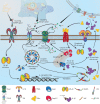The pannexins: past and present
- PMID: 24600404
- PMCID: PMC3928549
- DOI: 10.3389/fphys.2014.00058
The pannexins: past and present
Abstract
The pannexins (Panxs) are a family of chordate proteins homologous to the invertebrate gap junction forming proteins named innexins. Three distinct Panx paralogs (Panx1, Panx2, and Panx3) are shared among the major vertebrate phyla, but they appear to have suppressed (or even lost) their ability to directly couple adjacent cells. Connecting the intracellular and extracellular compartments is now widely accepted as Panx's primary function, facilitating the passive movement of ions and small molecules along electrochemical gradients. The tissue distribution of the Panxs ranges from pervasive to very restricted, depending on the paralog, and are often cell type-specific and/or developmentally regulated within any given tissue. In recent years, Panxs have been implicated in an assortment of physiological and pathophysiological processes, particularly with respect to ATP signaling and inflammation, and they are now considered to be a major player in extracellular purinergic communication. The following is a comprehensive review of the Panx literature, exploring the historical events leading up to their discovery, outlining our current understanding of their biochemistry, and describing the importance of these proteins in health and disease.
Keywords: Panx1; Panx2; Panx3; biochemistry; distribution; gating; pannexin; structure.
Figures


References
Publication types
LinkOut - more resources
Full Text Sources
Other Literature Sources
Miscellaneous

